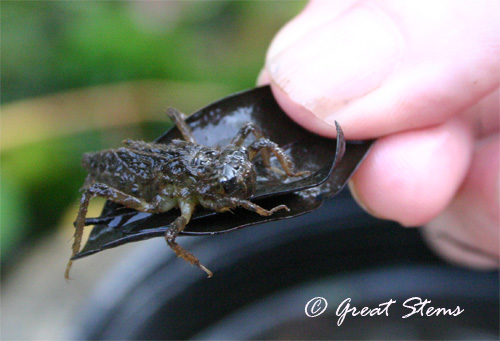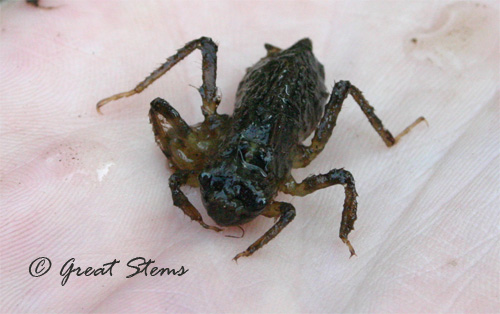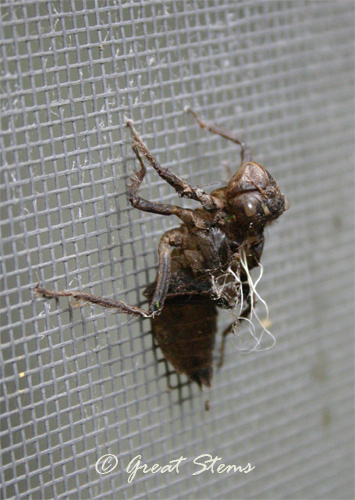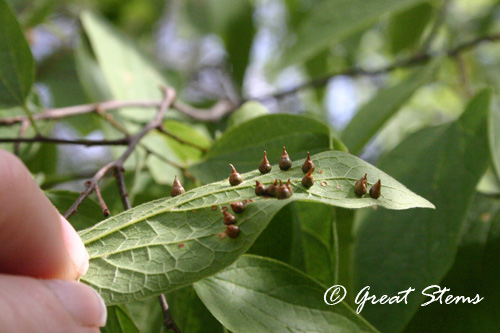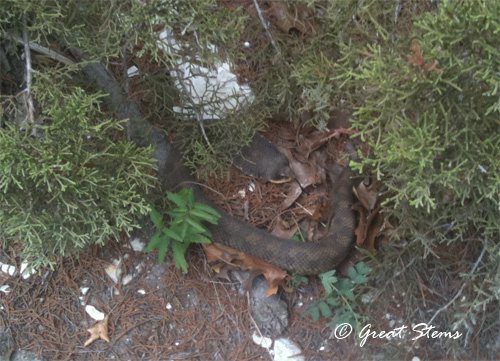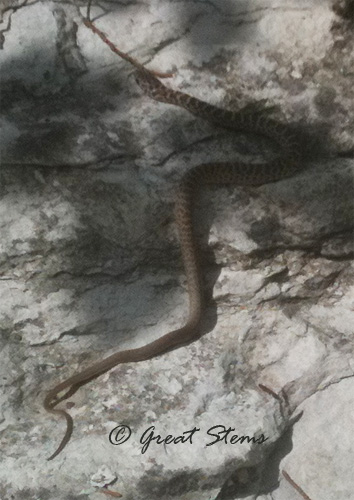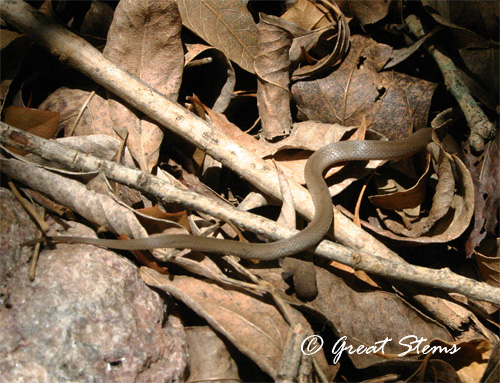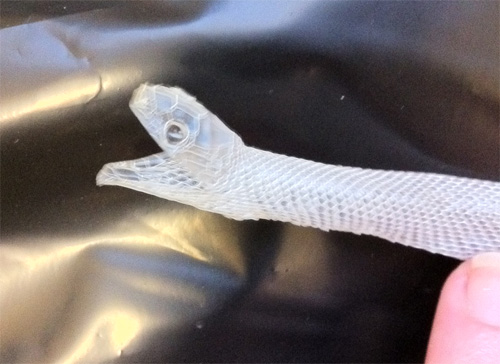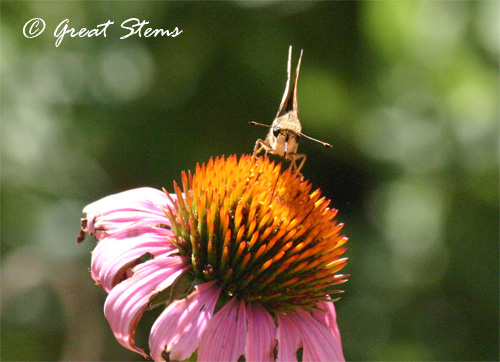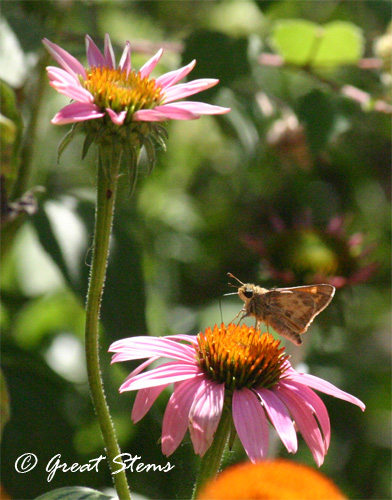You know you are with a bunch of naturalists when everyone in your group sighs in amazement at giant oak roots, gets down low to study and photograph tiny blooming flowers, and oohs and aahs over rattlesnakes, fungus, and scorpions. That was our day at the Commons Ford Ranch, a beautiful 215-acre former Hill Country ranch located in the outskirts of Austin. I can't resist sharing a few pictures.
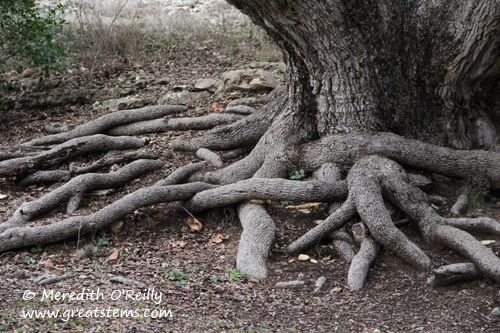
When our CAMN group arrived at the ranch, we were mesmerized by the massive root system on this stunning live oak tree.
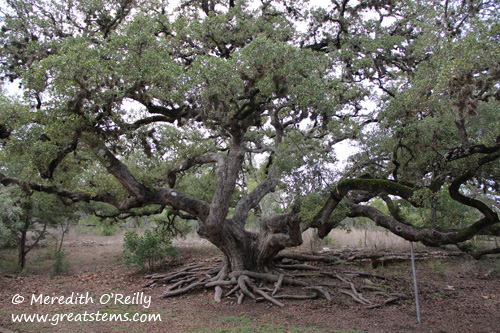
That's one giant and very old tree, so big that it needed a little bit of support. But if you think you are seeing the full size of this tree, think again.
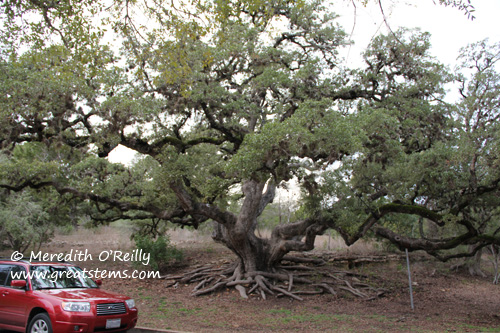
I backed up as far as I could and still couldn't get the whole tree in the picture.
Though you can't see it, I'm standing next to the old Commons Ford ranch house, one of those old-timey houses filled with wooden ceilings and wooden floors. Inside, I rushed off to explore room after room, each of which has nifty little built-in closets and cabinets and bookshelves -- even a built-in ironing board that reminded me of my grandmother's house. I was so delighted that I took not a single picture -- shame on me.
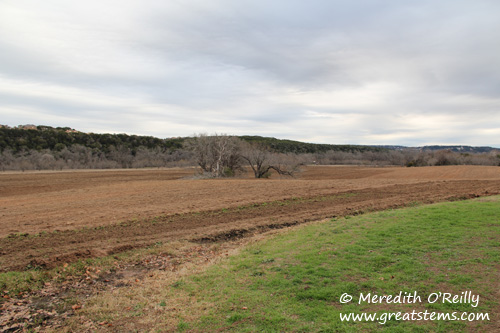
Thanks to the work of dedicated staff and volunteers, Commons Ford is undergoing a massive prairie restoration in order to provide habitat for bird species that should be present but have long been missing. And so the field has been cleared of its invasive KR bluestem and Johnsongrass, as well as overabundant mesquite, and is ready to be seeded this week with a carefully selected variety of native seeds appropriate to the area and the soil type.
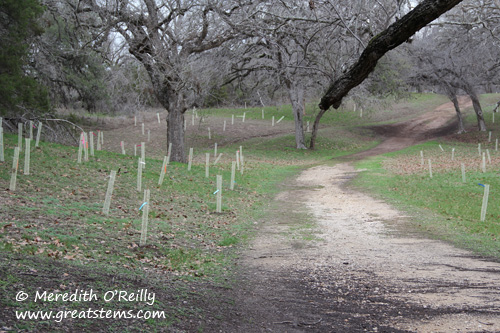
Down by the creek and elsewhere in the park, some 600 tree saplings have been planted by volunteers.
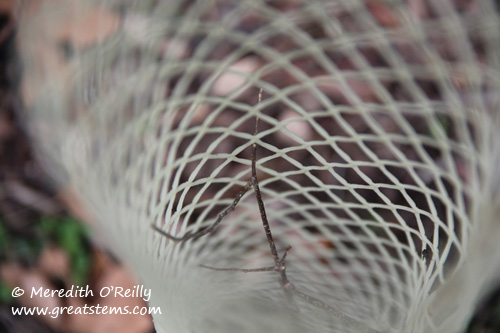
These little protectors will help people notice and hence avoid damaging the young trees.
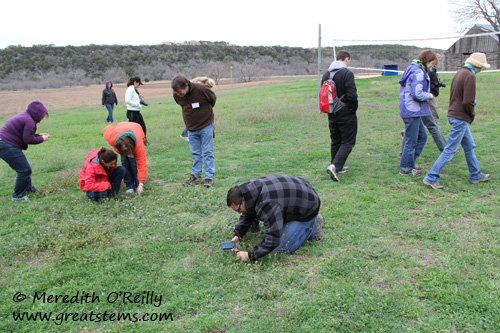 In a field up at the house, we got up close and personal with nature, studying assorted winter annuals (which seemed to be mostly non-native Shepherd's Purse, Henbit, and Pin Clover in that particular area).
In a field up at the house, we got up close and personal with nature, studying assorted winter annuals (which seemed to be mostly non-native Shepherd's Purse, Henbit, and Pin Clover in that particular area).
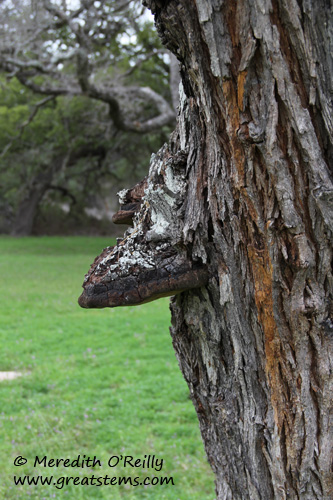 Shelf Fungus.
Shelf Fungus.
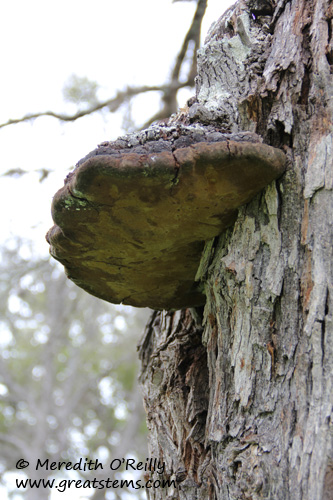 It's appropriately named.
It's appropriately named.
Of everything we saw, I'm fairly confident that the highlight for everyone that morning was this gorgeous creature:
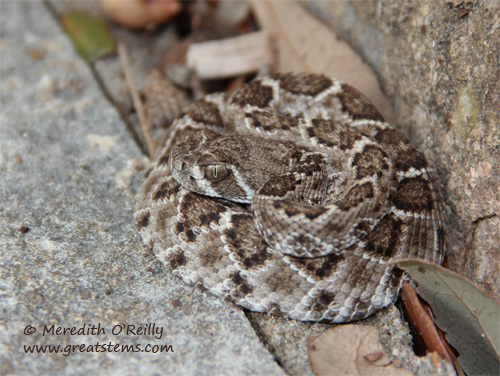
Yes, it's a young rattlesnake, specifically a juvenile Western Diamondback Rattlesnake. We were amazed to see it on a chilly February morning, but there it was coiled up on a stone step of all places. Because it was cold, we were able to get a little closer than we would normally have done, and between all of us, I think hundreds of pictures were taken. The little snake was certainly watching us, but the only movement it made was the occasional flicking of its forked black tongue (eventually the snake did retreat to the safety of a crevice, and it was reported that the snake had one cute little rattle).
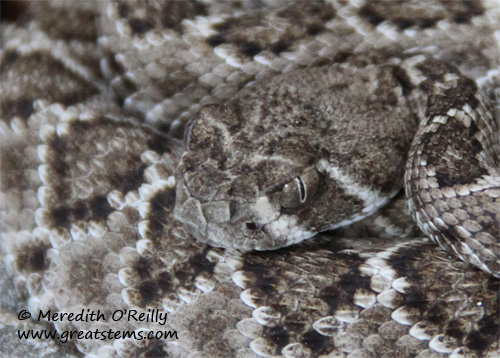 Look closely, and you'll see what makes rattlesnakes so easily recognizable. Don't focus on the pattern -- aside from the fact that there are lots of variations among a single species, many other snakes share a somewhat similar coloration and pattern. This has led to perfectly harmless snakes being killed by people who just didn't care to take a better look. You also can't go just by the sound of a rattling tail -- many species of snakes rattle their tail as a warning sign, whether or not they even have an actual rattle. Your best bet is to study the head.
Look closely, and you'll see what makes rattlesnakes so easily recognizable. Don't focus on the pattern -- aside from the fact that there are lots of variations among a single species, many other snakes share a somewhat similar coloration and pattern. This has led to perfectly harmless snakes being killed by people who just didn't care to take a better look. You also can't go just by the sound of a rattling tail -- many species of snakes rattle their tail as a warning sign, whether or not they even have an actual rattle. Your best bet is to study the head.
Remember that a rattlesnake is a pit viper. It has heat-sensing organs between its eyes and nostrils (look for the dark spot to the right of the snake's nostril above). It also has very cool vertical, elliptical pupils, and its head is spade-shaped. Compare it to corn/rat snakes and you'll notice a vast difference.
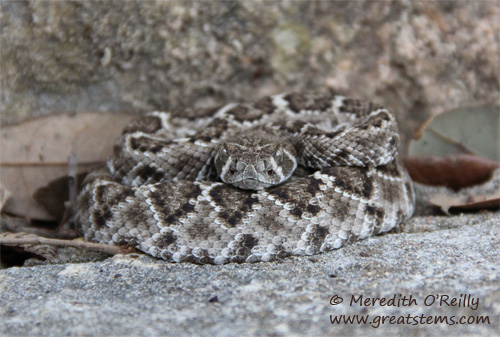
I particularly like the angry look its supraocular scales (effectively eyebrows) give it -- the resulting expression is one that says, "Don't mess with me."
Inside the house's kitchen, we discovered another guardian against all things pest-like.
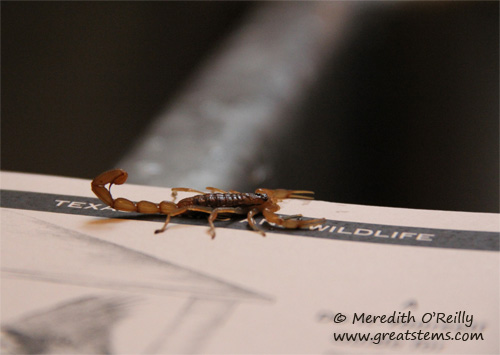 How appropriate that this scorpion sits surrounded by the words "Texas...Wildlife" (it's sitting on a booklet from Texas Parks and Wildlife). Despite the alarm scorpions bring people, they are actually beneficial little creatures. Yes, they can sting (it's described as "moderate"). I've experienced it, as has my husband, and one of my sons did, too, when he was a toddler. For each of us the sting only lasted a few hours at most -- to me, fire-ant bites are far worse. Sensitivity varies with each person, of course, and there's always the risk of anaphylactic shock. But overall, scorpions are good guys and worth being given a chance. Among their dietary favorites are cockroaches. While I personally feel that's all I need to say to prove their value, I'll point out that they also eat crickets, grasshoppers, ants, beetles, spiders, even other scorpions.
How appropriate that this scorpion sits surrounded by the words "Texas...Wildlife" (it's sitting on a booklet from Texas Parks and Wildlife). Despite the alarm scorpions bring people, they are actually beneficial little creatures. Yes, they can sting (it's described as "moderate"). I've experienced it, as has my husband, and one of my sons did, too, when he was a toddler. For each of us the sting only lasted a few hours at most -- to me, fire-ant bites are far worse. Sensitivity varies with each person, of course, and there's always the risk of anaphylactic shock. But overall, scorpions are good guys and worth being given a chance. Among their dietary favorites are cockroaches. While I personally feel that's all I need to say to prove their value, I'll point out that they also eat crickets, grasshoppers, ants, beetles, spiders, even other scorpions.
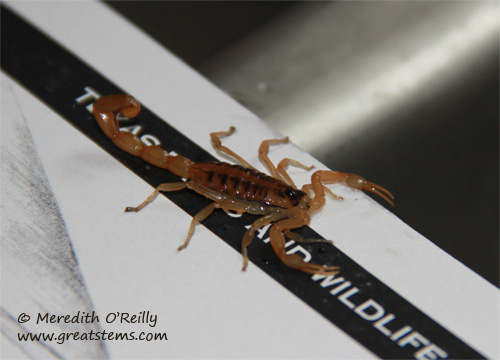
Though Texas has 18 to 20 species of scorpions, only two are found are in Central Texas. This little scorpion is a Striped Bark Scorpion (Centruroides vittatus), the most common. It is easily recognizable by its two dark stripes down its back and the dark triangular mark on its head. Our other Central Texas scorpion is the Texas Cave Scorpion (Pseudouroctonis reddelli).
It's important to be tolerant of nature and recognize the role that different animals have in their natural habitat. That doesn't mean you have to accept a rattlesnake in your backyard, but rather than rush to kill such a valuable predator, investigate whether a skilled wildlife person or snake expert can remove it for you. Be kind to ordinary garden snakes, too -- you don't have to do a happy snake dance like I do (more like rush to get the camera and take a thousand pictures) -- but do be glad if they do come visit to help balance the creatures in your garden. Scorpions, too -- let them do their job outside. If you find them inside the house, just scoop them into a cup and take them to the backyard.
So this topic of scorpions led to an online chat I had with my husband. I'll just post it word-for-word here.
Meredith: I wonder if we can thank our scorpions for being a reason why we have very few cockroaches and crickets.Michael: I think that's a reasonable guess.Meredith: I think we can -- scorpions and lizards and snakes, too.Michael: All our little friends.Meredith: "Scorpions have tiny mouths, so they do most of their digesting externally by coughing up digestive fluids onto their prey and then sucking up the liquefied remains. If it helps, you can think of it as akin to drinking a nutritious smoothie." [description by Alex R. at EarthSky].Michael: Mmmm....Meredith: If you're still hungry, you could try that technique. Got a nearby coworker?Michael: In fact I am still hungry. AFK a moment to try.Meredith: lolMichael: I'll have to come up with an explanation for Lee as to why I'm coming over to throw up on him.Meredith: Oh wait, you don't have a tiny mouth. Perhaps the throwing up isn't necessary.Michael: Well, it's kind of tiny compared to the rest of me.Meredith: True, and since you don't have a tail stinger full of venom to help you subdue your prey, you might try farting.Michael: Oh, how I do try that! They never get subdued, though. Quite the opposite.
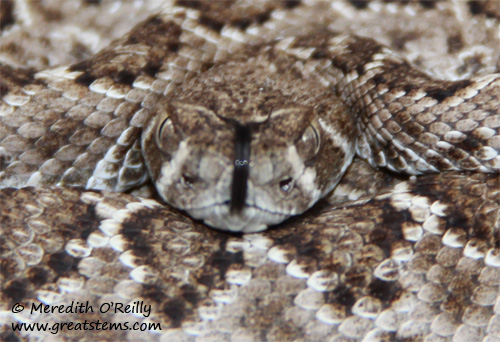

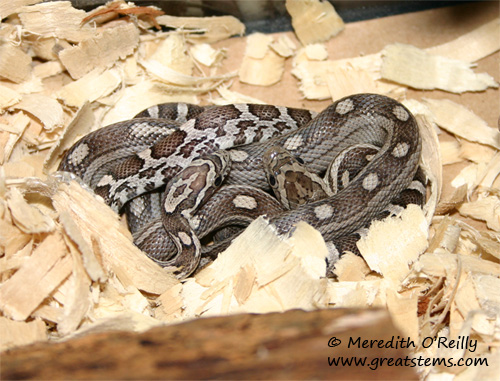
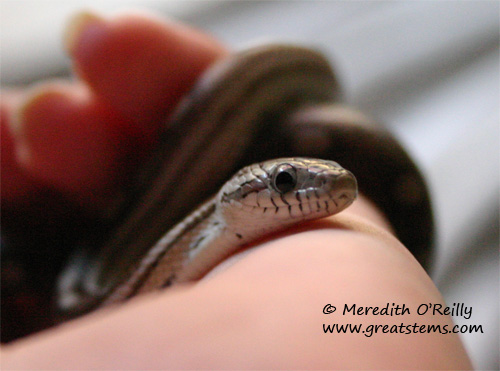
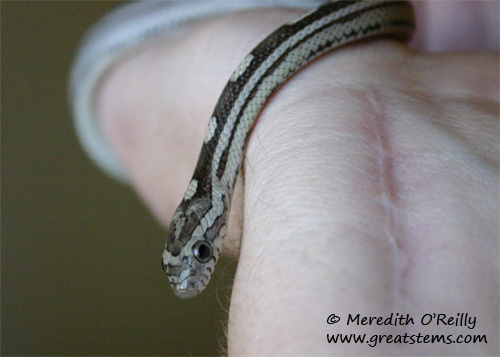 She is a corn snake, one that is an anerythristic motley (meaning she lacks red pigmentation and has that dotted pattern you see on her dorsal side). She likes to climb and explore, but she is also content to entwine herself through your fingers or to wrap around your wrist until you have a serpentine bracelet.
She is a corn snake, one that is an anerythristic motley (meaning she lacks red pigmentation and has that dotted pattern you see on her dorsal side). She likes to climb and explore, but she is also content to entwine herself through your fingers or to wrap around your wrist until you have a serpentine bracelet. 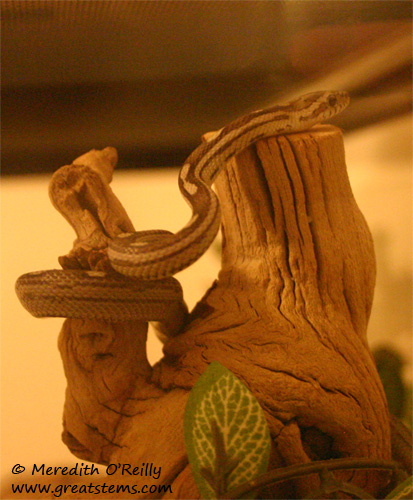
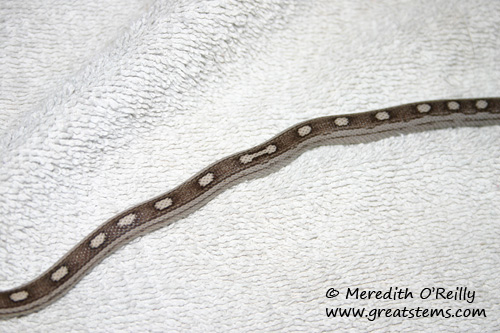
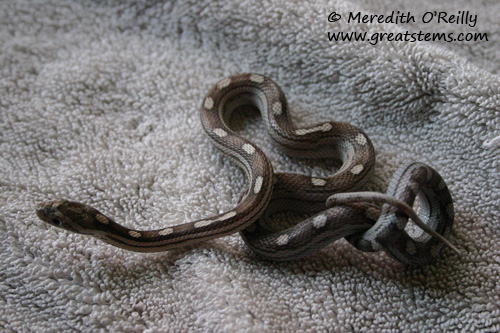
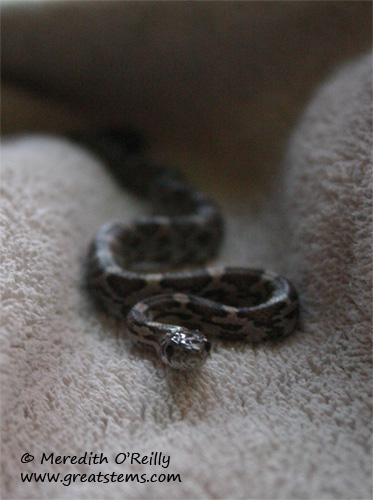
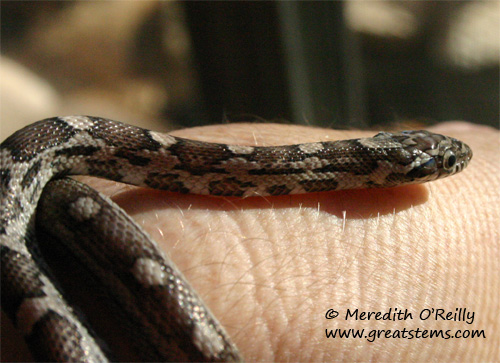
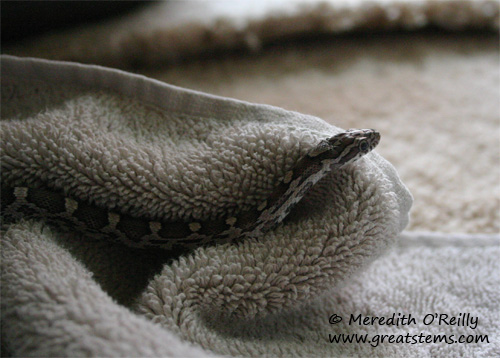
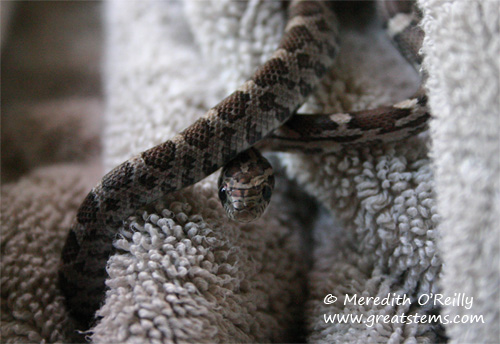 He's most content staying on the ground, of course, and he moves quite comfortably on a relatively flat surface. And so we named our legless pet Walker, after MUCH deliberation, discussion, voting, and compromise between members of my family. A little bribing might have happened, too -- hey, we know how politics work! For the record, Walker is his last name -- now we're deliberating, discussing, and so forth on the initials that will someday be in front of his name.
He's most content staying on the ground, of course, and he moves quite comfortably on a relatively flat surface. And so we named our legless pet Walker, after MUCH deliberation, discussion, voting, and compromise between members of my family. A little bribing might have happened, too -- hey, we know how politics work! For the record, Walker is his last name -- now we're deliberating, discussing, and so forth on the initials that will someday be in front of his name. 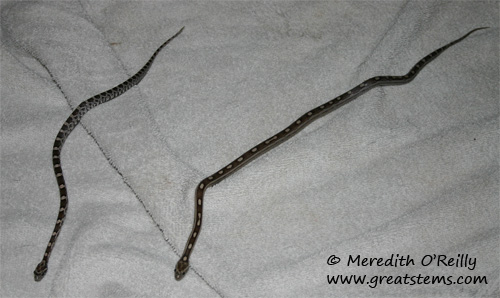
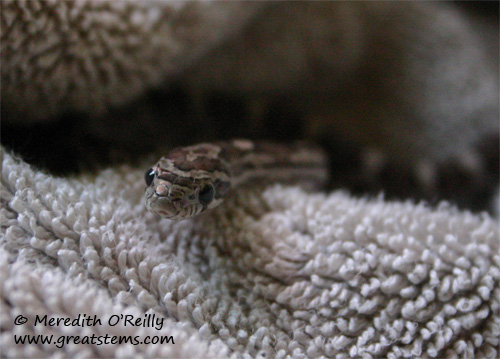
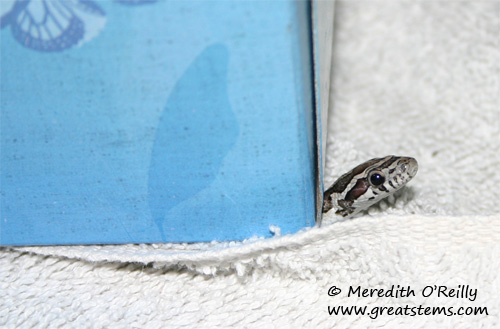
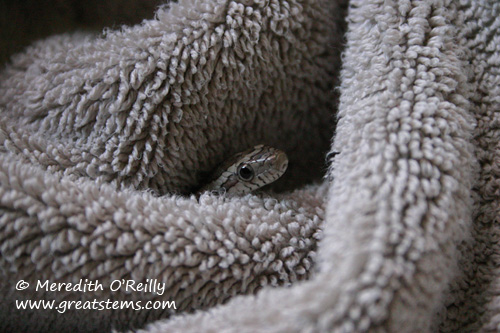
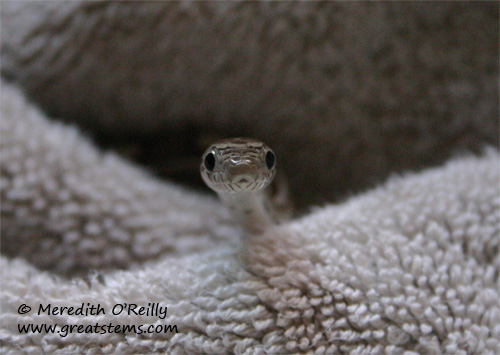
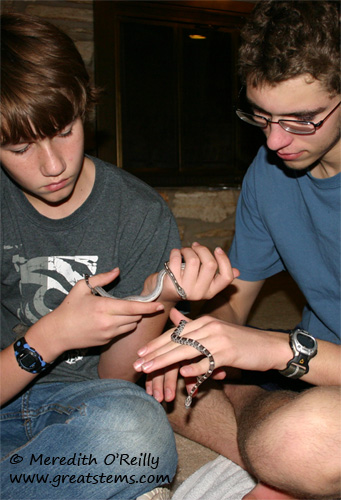
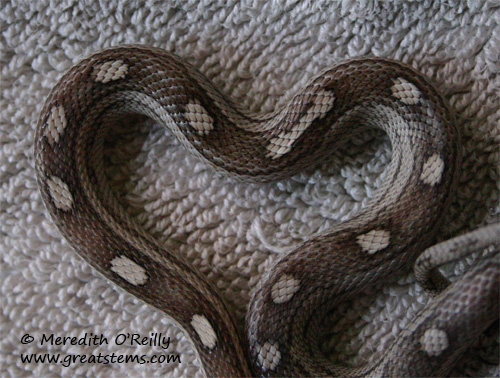
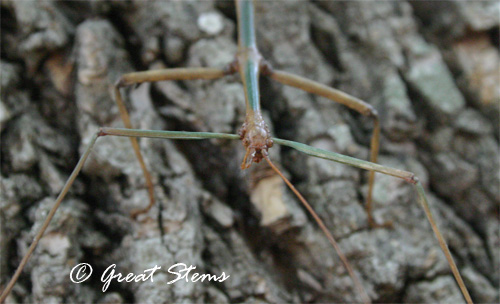
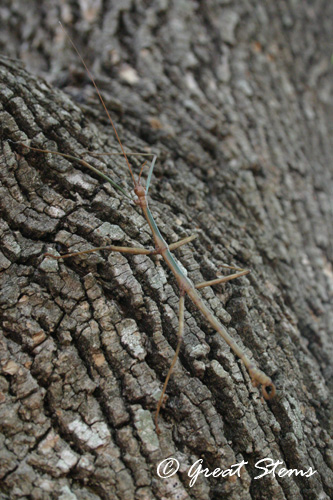
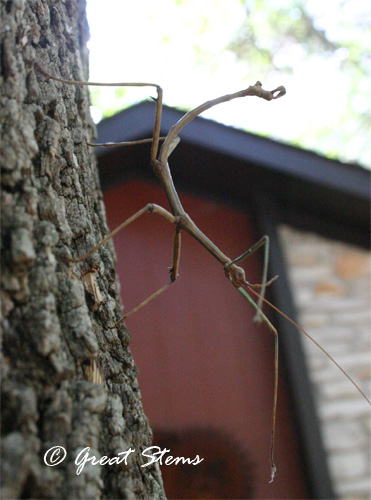
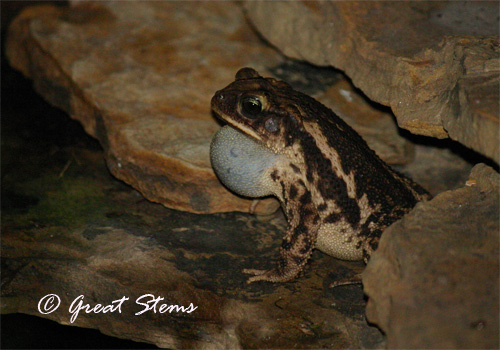 The male toads are singing each night, doing their best to entice a female for a dip in the pond.
The male toads are singing each night, doing their best to entice a female for a dip in the pond.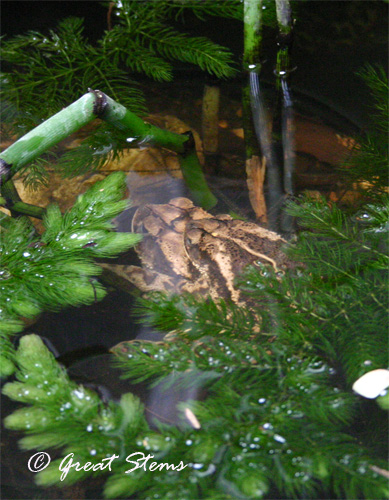
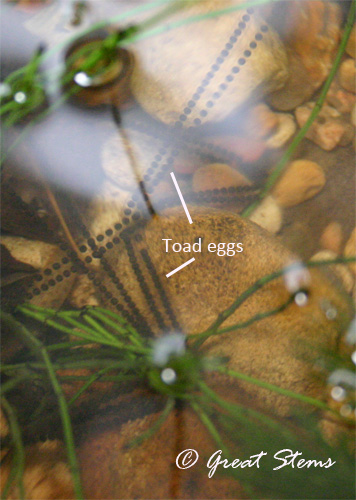
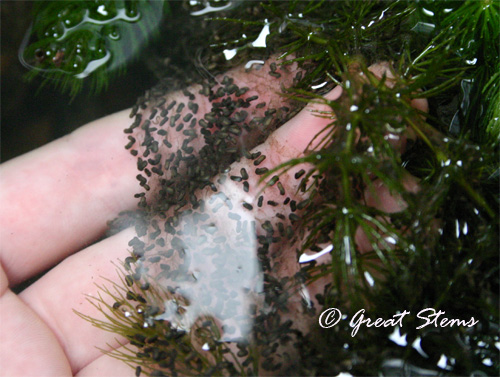
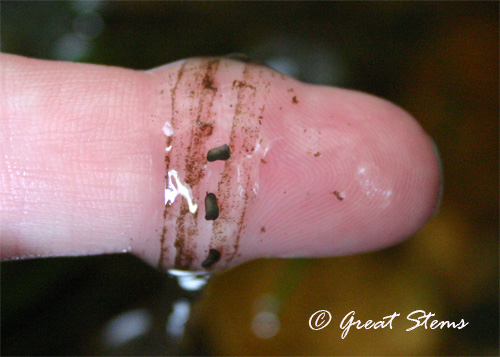
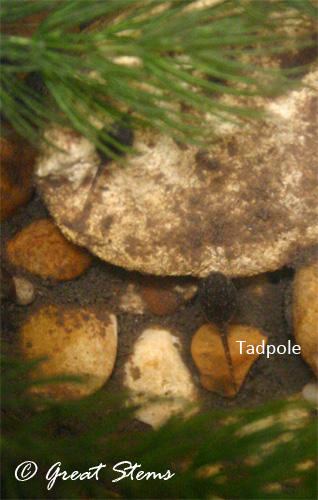 Despite the great numbers of eggs laid, very few make it to adulthood to live the life of a toad. They become food for other creatures, including the one below.
Despite the great numbers of eggs laid, very few make it to adulthood to live the life of a toad. They become food for other creatures, including the one below.